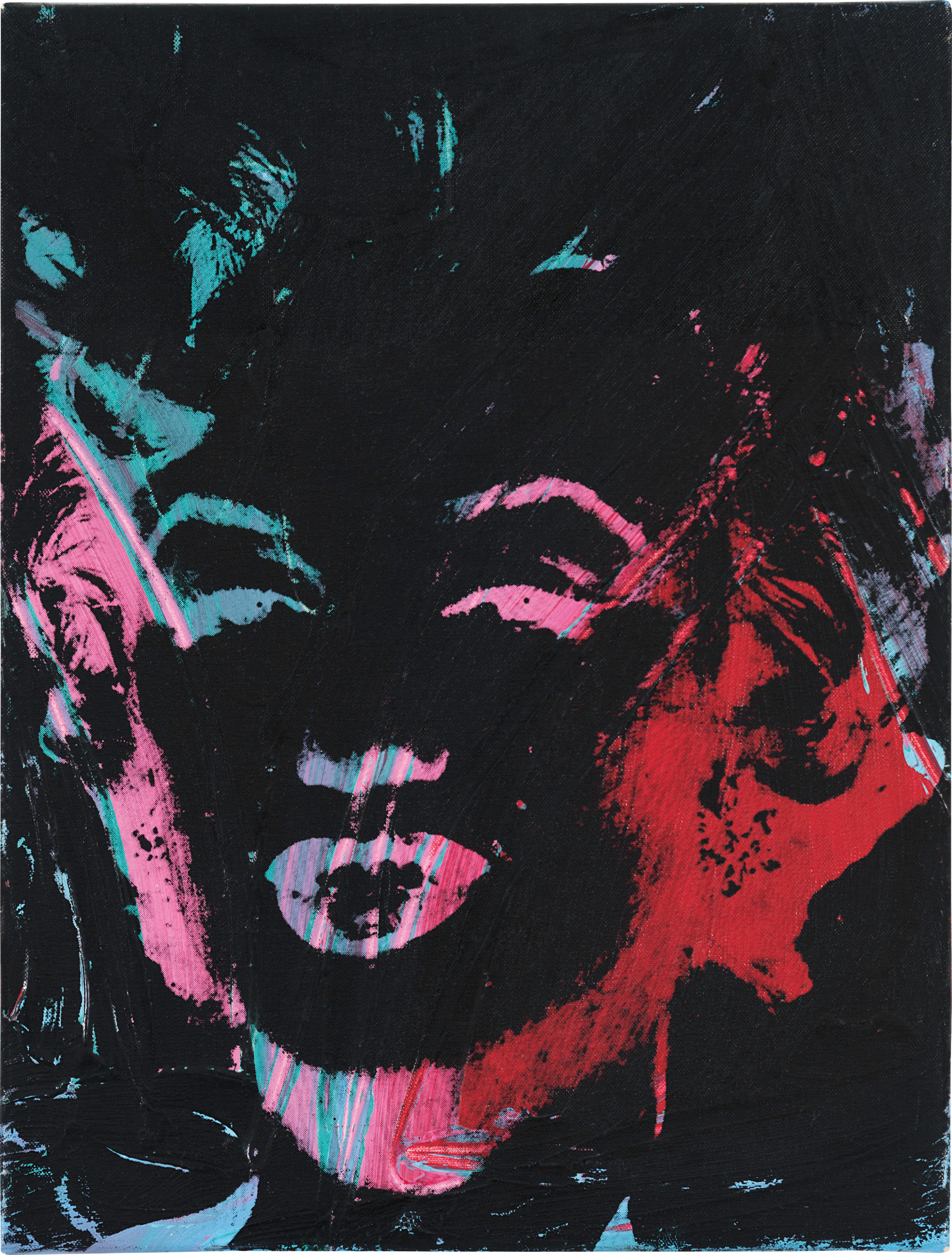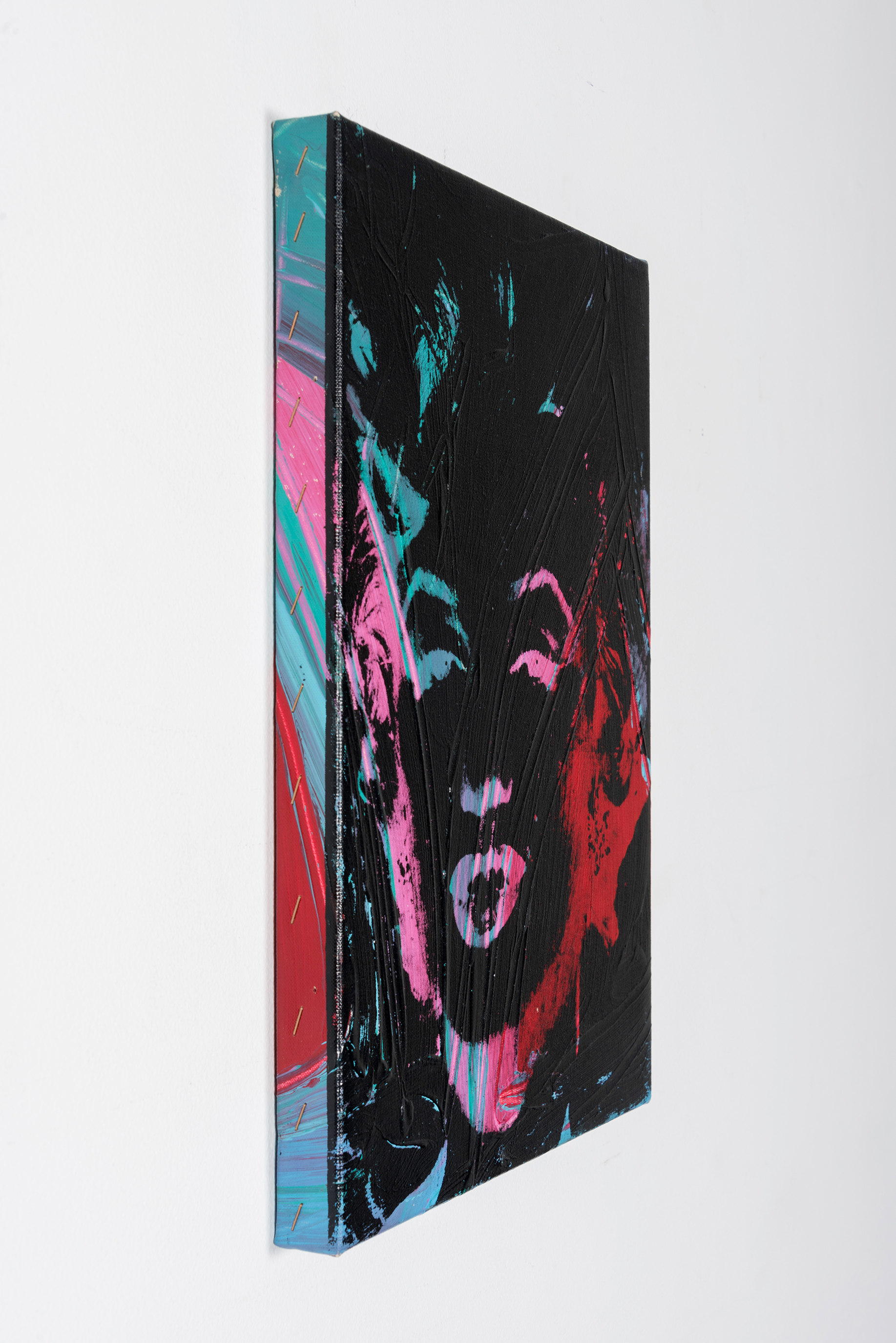





18Ο
Andy Warhol
1 Colored Marilyn (reversal series)
Full-Cataloguing
Perhaps no other protagonist in Warhol’s prolific career received such sustained, fervent attention as that of Marilyn Monroe. From his original ground-breaking series of paintings in 1962 based on a publicity shot from the 1953 film Niagara to the present series conceived nearly two decades later, Warhol cropped, colored, re-screened, repeated and replicated his muse in almost endless permutations. Indeed in many ways, Warhol and Marilyn have become two sides of a single coin. His singular representation of Marilyn has arguably come to surpass all other pop culture images of the actress, perhaps second only to the iconic scene from The Seven Year Itch, 1955. By the same token, she has also become a touchstone of sorts for some of the most pervasive conceptual interrogations in his own practice, namely those of glamor, beauty and death.
Of all the imagery from the Reversals series, the Marilyns are widely considered the most successful for their ability to create a lasting impression through their haunting intensity. The series brought together iconography from his own pantheon of such well-known subjects as his Flowers, Maos and Marilyns. With the plunder from his own visual lexicon, Warhol reversed the images of his earlier paintings resulting in “negatives” of sorts that played on ideas of photographic appropriation and the duration of his own art historical legacy. For this reason, the Reversals have a fascinating resonance, ultimately elevating his own oeuvre through the merging of old and new. As David Bourdon espoused, “Warhol’s Reversals recapitulate his portraits of famous faces... but with the tonal values reversed. As if the spectator were looking at photographic negatives, highlighted faces have gone dark while former shadows now rush forward in electric hues. Sometimes this results in extravagantly melodramatic images. The reversed Marilyns, especially, have a lurid, otherworldly glow, as if illuminated by internal footlights” (David Bourdon, Warhol, New York, 1989, p. 378).
Through the inverted composition put forward in 1 Colored Marilyn, Warhol takes his iconic image and materializes it into something akin to a photographic negative. In so doing, Warhol creates intriguing parallels between the re-imaging of his own work, as well as that of Monroe in visual culture. As in a photographic negative, features that were once highlighted are now voided expanses of negative space. By inverting the tonalities of light and shadow, the profile in 1 Colored Marilyn manifests in a kaleidoscope of color, pulsating with vitality. In a fortuitous alignment of chance, the gestural swathes of day-glo colors emerge from the lustrous black screen in such a way as to imply a face seen in chiaroscuro. And yet that very gesturality is what imbues the work with an overarching sense of abstraction, a theme that was currently preoccupying the artist in his Shadows series, 1978-1979. Indeed this gestural handling of paint marked a turning point in the artist’s oeuvre and finds perhaps its earliest precedent in Warhol’s large-scale Mao paintings from 1973. Warhol embarked on this series after nearly a decade away from painting, having “retired” from the practice in 1965 to focus on his films. Unlike works from his earlier practice, Warhol rendered his Maos in a more painterly style, freely brushing a somewhat expressionist background of colors before silkscreening the image. Warhol’s explorations into the possibilities of paint culminated in this reconciliation of his more manufactured Pop handling of medium from the 1960s with this more painterly style reaffirmed in his Reversals.
By revisiting the subject-matter that both defined his own practice and an art movement at large, Warhol’s Reversals traverse the trajectory of his own career, refreshing his oeuvre for a new generation and providing a post-modern reinterpretation of his own art. By mining his own canon of imagery, Warhol’s Reversals became powerfully self-referential, “trademarking” his own lexicon in a move that would anoint him as a leading practitioner of the post-modern aesthetic. With this series, Warhol simultaneously extends his legacy and subverts it, and in doing so, brings his oeuvre one step closer to the Conceptual art practices that had been developing contemporaneously with his own practice through the 1960s and into the 1970s. The Reversals draw intriguing parallels with Marcel Duchamp and his appropriation of existing, readymade objects to become elevated to artworks in their own right. However, Warhol takes this notion one step further, classifying his own art as readymades, existing in in a space independent from his own place as artist. This concept also points toward the pursuits of a contemporaneous generation of appropriation artists working at the time such as the Pictures Generation.
As David Bourdon espoused, “By ransacking his own past to produce the Reversal and Retrospectives, Warhol revealed himself to be one of the shrewdest of the new wave of post-modernists. While modernism has been an ideal that survived throughout most of the 1960s, continuing its self-conscious search for new forms of expression, post-modernism, which gained currency in the ‘pluralist’ 1970s, reflected an ironic attitude toward all aesthetic camps and displayed an indifference to traditional hierarchies of ‘high’ and ‘low’ art” (David Bourdon, Warhol, New York, 1989, p. 380). From appropriation to re-appropriation, the Reversals draw to a poignant conclusion to Warhol’s oeuvre, ending it where it began. In 1 Colored Marilyn, Warhol creates the ultimate self-reflexive gesture—an homage to himself and his first Marilyns—and in doing so, cements his place as one of the forefathers of post-modernity.
Andy Warhol
American | B. 1928 D. 1987Andy Warhol was the leading exponent of the Pop Art movement in the U.S. in the 1960s. Following an early career as a commercial illustrator, Warhol achieved fame with his revolutionary series of silkscreened prints and paintings of familiar objects, such as Campbell's soup tins, and celebrities, such as Marilyn Monroe. Obsessed with popular culture, celebrity and advertising, Warhol created his slick, seemingly mass-produced images of everyday subject matter from his famed Factory studio in New York City. His use of mechanical methods of reproduction, notably the commercial technique of silk screening, wholly revolutionized art-making.
Working as an artist, but also director and producer, Warhol produced a number of avant-garde films in addition to managing the experimental rock band The Velvet Underground and founding Interview magazine. A central figure in the New York art scene until his untimely death in 1987, Warhol was notably also a mentor to such artists as Keith Haring and Jean-Michel Basquiat.